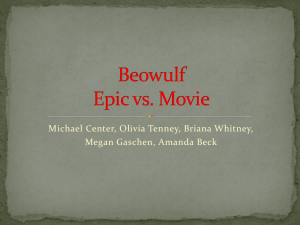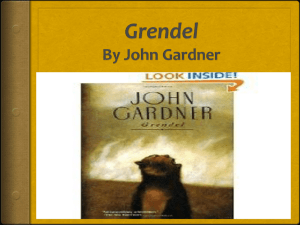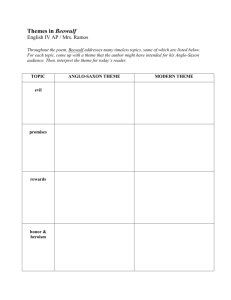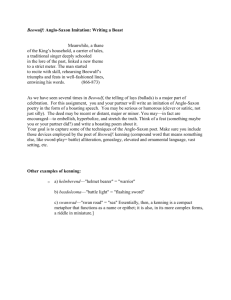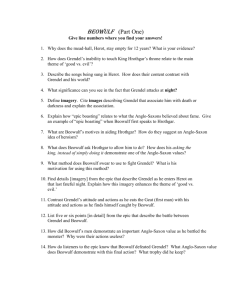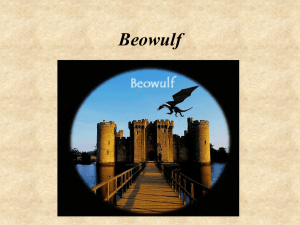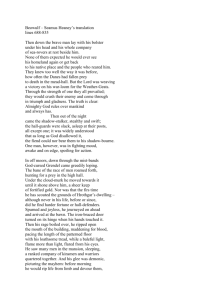The Anglo-Saxon Period
advertisement
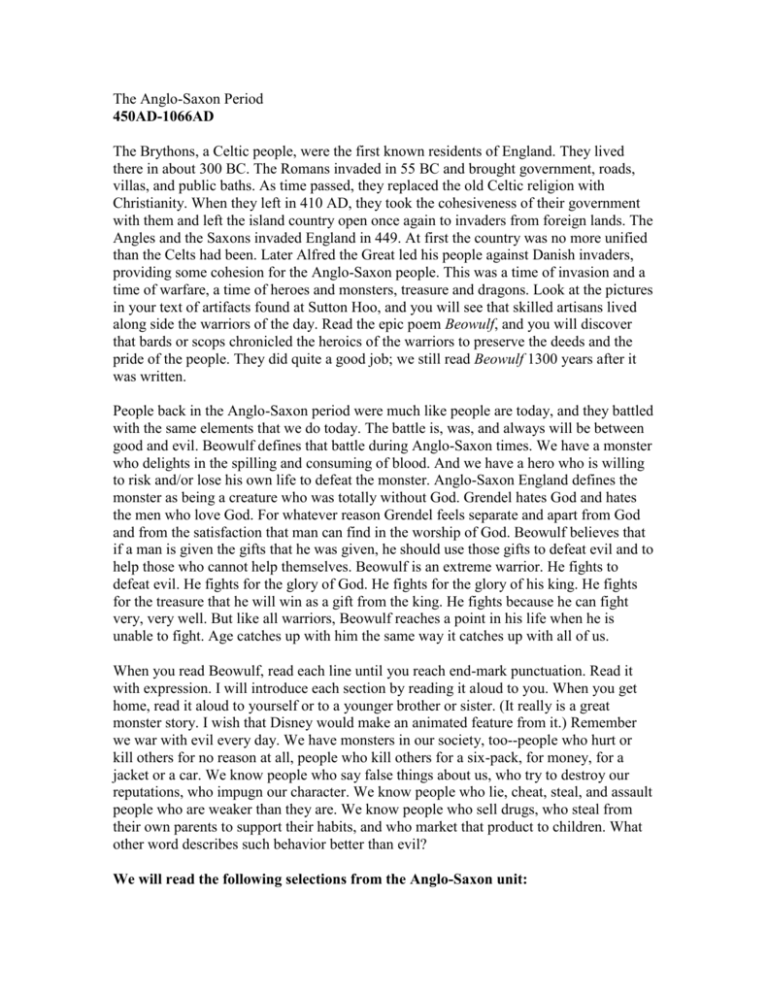
The Anglo-Saxon Period 450AD-1066AD The Brythons, a Celtic people, were the first known residents of England. They lived there in about 300 BC. The Romans invaded in 55 BC and brought government, roads, villas, and public baths. As time passed, they replaced the old Celtic religion with Christianity. When they left in 410 AD, they took the cohesiveness of their government with them and left the island country open once again to invaders from foreign lands. The Angles and the Saxons invaded England in 449. At first the country was no more unified than the Celts had been. Later Alfred the Great led his people against Danish invaders, providing some cohesion for the Anglo-Saxon people. This was a time of invasion and a time of warfare, a time of heroes and monsters, treasure and dragons. Look at the pictures in your text of artifacts found at Sutton Hoo, and you will see that skilled artisans lived along side the warriors of the day. Read the epic poem Beowulf, and you will discover that bards or scops chronicled the heroics of the warriors to preserve the deeds and the pride of the people. They did quite a good job; we still read Beowulf 1300 years after it was written. People back in the Anglo-Saxon period were much like people are today, and they battled with the same elements that we do today. The battle is, was, and always will be between good and evil. Beowulf defines that battle during Anglo-Saxon times. We have a monster who delights in the spilling and consuming of blood. And we have a hero who is willing to risk and/or lose his own life to defeat the monster. Anglo-Saxon England defines the monster as being a creature who was totally without God. Grendel hates God and hates the men who love God. For whatever reason Grendel feels separate and apart from God and from the satisfaction that man can find in the worship of God. Beowulf believes that if a man is given the gifts that he was given, he should use those gifts to defeat evil and to help those who cannot help themselves. Beowulf is an extreme warrior. He fights to defeat evil. He fights for the glory of God. He fights for the glory of his king. He fights for the treasure that he will win as a gift from the king. He fights because he can fight very, very well. But like all warriors, Beowulf reaches a point in his life when he is unable to fight. Age catches up with him the same way it catches up with all of us. When you read Beowulf, read each line until you reach end-mark punctuation. Read it with expression. I will introduce each section by reading it aloud to you. When you get home, read it aloud to yourself or to a younger brother or sister. (It really is a great monster story. I wish that Disney would make an animated feature from it.) Remember we war with evil every day. We have monsters in our society, too--people who hurt or kill others for no reason at all, people who kill others for a six-pack, for money, for a jacket or a car. We know people who say false things about us, who try to destroy our reputations, who impugn our character. We know people who lie, cheat, steal, and assault people who are weaker than they are. We know people who sell drugs, who steal from their own parents to support their habits, and who market that product to children. What other word describes such behavior better than evil? We will read the following selections from the Anglo-Saxon unit: Introduction to the Anglo-Saxon period pp. 2-16 Introduction to Beowulf pp. 18-20 Beowulf a. The monster Grendel pp.21-23--We meet the monster who can kill and then carry thirty men home to his lair. We see him as he watches Hrothgar's men celebrate God's creation. He is on the outside, looking in. b. The Arrival of the Hero pp. 24-27--Beowulf has to prove himself before he is allowed to battle Grendel. He has to convince Hrothgar that he is able to defeat the monster who is laying waste to Herot. c. Unferth’s Challenge pp. 27-32--Poor Unferth! He has been unable or unwilling to challenge Grendel. And he resents that Beowulf might get the glory that he has been denied. d. The Battle with Grendel pp. 32-38--Beowulf waits until Grendel kills one of Beowulf's own men before he attacks Grendel himself. Why does he do this? e. The Monster’s Mother pp. 39-42--This is a tougher battle. Beowulf takes in more armor, more ammunition than he used when fighting Grendel. Does he win? What does he take with him? What is the instrument that he finally uses in his battle? f. The Final Battle pp. 42-46--Beowulf has ruled the Geats for 50 years. He is an old man. But he is still a warrior. Only one man stays by his side in his fight against the dragon. Does Beowulf win or does he lose? Does he live or does he die? Read to find out. g. from Grendel p.36-People, Terms, and Concepts: Qualities of an epic animism *Druids invaders of England *Loyal dependency *wyrd Odin bard/scop/troubadour Anglo-Saxon ethics alliteration Sutton Hoo caesura Kenning contributions of the Romans King Alfred importance of treasure *Cain and Abel Brecca Beowulf Herot Grendel Unferth Hrothgar Wiglaf Welthow reaction of Unferth to Beowulf Hrothgar’s throne Beowulf’s supernatural abilities Source of Beowulf’s obligation Grendel’s mother’s retaliation Mix of Christianity and paganism the giant’s sword Grendel’s death Old English The monster’s lake home proof of the monsters’ deaths Beowulf’s protection Grendel’s mother’s death *The dragon and the treasure The next king The legacy of Beowulf to Wiglaf *--listen in class for information about these items. They are important. Anglo-Saxon poetry has the following characteristics: 1. The lines do not rhyme. In this respect Anglo-Saxon poetry is like blank verse. 2. The rhythm of a line depends primarily on the number of beats or accented syllables. Each line has four beats. 3. Reflected the juxtaposition of the Church and the pagan world 4. Each line has a pause or caesura after the second beat. Thus, each line is divided into two halves, each half having two beats. 5. Alliteration is an important element in Anglo-Saxon poetry. One or more accented syllables in the first half of a line almost always alliterate with one or more accented syllables in the second half. Thus alliteration binds together the two halves of a line. 6. The use of kennings, phrases that are an elaborate and indirect way of naming persons, things, or events, is another important characteristic of Anglo-Saxon poetry. It was a distinctive element of Anglo-Saxon poetry. For instance the sea is called "the pathless deep" and the body is the soul’s "prison house." Hrothgar is referred to as "the Scyding’s friend" and Grendel is the "man-devourer." Sometimes a kenning was unusual and would force the audience to be alert and use its wits. Sometimes it was a synonym that had been used many times before, such as a "ring-giver" in reference to the king or "wave skimmer" in reference to a ship. An Anglo- Saxon audience hearing of Beowulf’s determination to "O’er the swanroad" would know that he meant to travel over the sea. 7. Tendency toward didacticism or a tendency to instruct on a moral lesson. Characteristics of Epic Poetry: 1. Long 2. Narrative 3. Larger than life hero 4. Embodies values of a particular society 5. Includes elements of myth, legend, folklore, history 6. Has a serious tone 7. Uses more formal, almost grand language Characteristics of Anglo-Saxon culture: 1. bravery in battle 2. loyalty for king or leader 3. bards or poets were used to elevate heroes of the tribes and were usually as important as the warriors themselves 4. faith in God to intervene positively with fate 5. influence of old religion—paganism 6. warfare was the order of the day 7. amassing a fortune in battle The Beginnings 700 BC—Celts dominated most of what is now western and central Europe; introduced iron to the rest of Europe; highly developed religion (animism), mythology, and legal system that specified the rights of the individual 55 BC—the Romans invaded and conquered; during their occupancy, Christianity became a unifying force and the old Celtic religion began to disappear 410—the Romans withdrew because of problems at home; they left roads, walls, villas, public baths but no central government; Britain became a country of separate clans and was therefore open to invasion by non-Christian people from Germanic regions. The Invaders: Angles and Saxons from the Baltic shores of Germany Jutes from the peninsula of Jutland in Denmark The language of the Anglo-Saxons became the dominant language; the country took their name from the Angles which was Englalond, or England. It was during this Anglo-Saxon period that Beowulf was written, between 700 and 750 AD. It depicts a world, though, of the early 6th century. Concepts of Anglo-Saxon society: Loyal dependency Wyrd--the idea that you die when you die, that no one sings your song. Sacrifice of self for one’s king or leader Concepts from Beowulf: 1. Man’s positive interaction with his fate "…Fate saves The living when they drive away death by themselves." 2. definitive good and evil " Now he discovered—once the afflictor of men, tormentor of their days—what it meant to feud with Almighty God. 3. Greed as man’s downfall "…(So gold can easily Triumph, defeat the strongest of men, No matter how deep it is hidden.) 4. vanity as man’s downfall "…but all the world turns When he spins it. How can he know when he sins?" 5. God’s positive intervention "…, and Holy God, who sent him victory, gave judgment For truth and right, Ruler of the Heavens Once Beowulf was back on his feet and fighting." 6. heroism epic hero=imposing, super-human character of cultural significance Anglo Saxon Ideals: Love of glory was a ruling motive Allegiance to the king or lord is cherished and demanded. Reverence for womanhood—precursor to chivalry—is expected There is a great love for personal freedom Open handed hospitality is the order of the day. Truth is a highly cherished virtue. Sentiments are usually suppressed Contrasts: Good and evil Heaven and hell Life and death Light and darkness Heroism and cowardice Cain and Abel God and Satan a. Herot—mead hall built by King Hrothgar b. Grendel—monster who attacks it c. Grendel’s mother—wants to avenge her son d. dragon—creature who protects treasure and represents death


